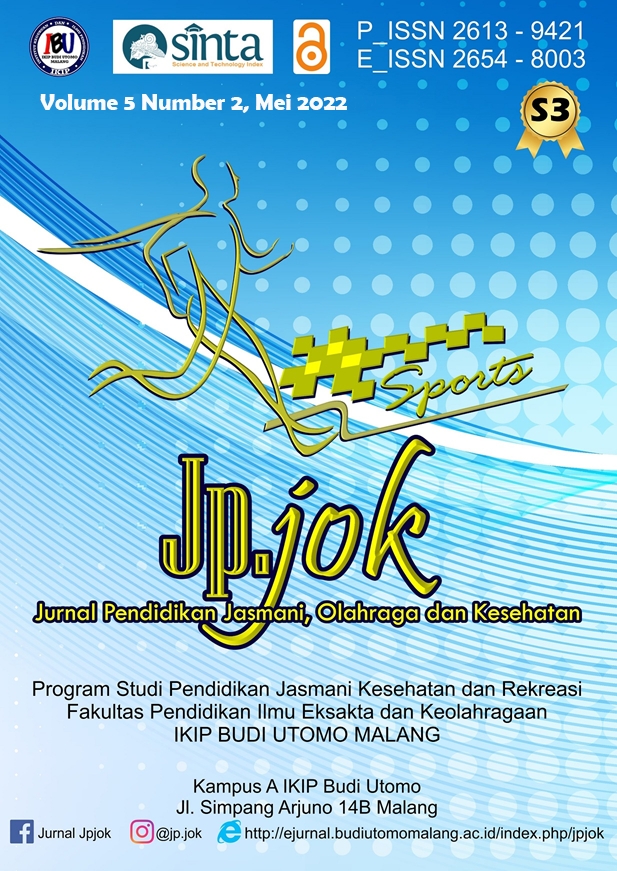The Effect of EMS Exercise on Body Circumstances in Sedentary Women
Abstract
Today's society is aware of the importance of health. Now many people are competing to do physical activity. This is done to prevent the occurrence of diseases such as diabetes, blockage of blood vessels caused by fat. Currently, there are many types of sports, one of which is Electro Muscle Stimulation (EMS). This EMS device uses electrical waves to artificially stimulate muscles. This research method is an experimental pretest-posttest design. The subject is female as many as 10 people. Exercises were carried out using a total body EMS with a duration of 20 minutes for core and 5 minutes for cooling down, performed 2x/week for 6 weeks. The exercise was carried out when the research subjects had enough sleep and the pulse was below 80-110 minutes. The variable in this study was subcutaneous fat with measurements using a simple meter to determine right-left upper arm circumference, abdominal circumference, right and left thigh circumference. The results of this study were that there were significant differences in the circumferences of the upper arms, abdomen and thighs where the results of the SPSS static analysis showed a value of <0.05.
References
Ahmad, M. F., & Hasbullah, A. H. (2015). The effects of electrical muscle stimulation (EMS) towards male skeletal muscle mass. International Journal of Sport and Health Sciences, 9(12), 864–873.
Canoy, D., Boekholdt, S. M., Wareham, N., Luben, R., Welch, A., Bingham, S., Buchan, I., Day, N., & Khaw, K. T. (2007). body fat distribution and risk of coronary heart disease in men and women in the european prospective investigation into cancer and nutrition in norfolk cohort: A population based prospective study. Circulation, 116 (25), 2933–2943. https://doi.org/10.1161/CIRCULATIONAHA.106.673756
Craig E, B., Amanda J, S., Steve, M., & Dimitria, V. (2018). The Metabolic Cardio-Respiratory Effects of Abdominal Electrical Muscle Stimulation. International Journal of Sports and Exercise Medicine, 4(2), 1–10. https://doi.org/10.23937/2469-5718/1510087
Francisco Jose Gondim, P., Cristiano Penas Seara, P., & Carmem Cristina, B. (2018). physical activity in the prevention of abdominal obesity: Type Durationand Intensity. International Journal of Sports and Exercise Medicine, 4(4), 1–4. https://doi.org/10.23937/2469-5718/1510106
Gollisch, K. S. C., Brandauer, J., Jessen, N., Toyoda, T., Nayer, A., Hirshman, M. F., & Goodyear, L. J. (2019). effects of exercise training on subcutaneous and visceral adipose tissue in normal and high fat diet fed rats. American Journal of Physiology - Endocrinology and Metabolism, 297(2), 495–504. https://doi.org/10.1152/ajpendo.90424.2008
Hwang, U. J., Jung, S. H., Kim, H. A., Kim, J. H., & Kwon, O. Y. (2020). Effect of Abdominal Electrical Muscle Stimulation Training With and Without Superimposed Voluntary Muscular Contraction on Lumbopelvic Control. Journal of Sport Rehabilitation, 29(8), 1137–1144. https://doi.org/10.1123/JSR.2019-0348
Kemmler, W., Teschler, M., Weißenfels, A., Bebenek, M., Fröhlich, M., Kohl, M., & Von Stengel, S. (2016). Effects of Whole-Body Electromyostimulation versus High-Intensity Resistance Exercise on Body Composition and Strength: A Randomized Controlled Study. Evidence-Based Complementary and Alternative Medicine. https://doi.org/10.1155/2016/9236809
Kemmler, W., & von Stengel, S. (2013). whole body electromyostimulation as a means to impact muscle mass and abdominal body fat in lean sedentary older female adults: subanalysis of the test-III trial. Clinical Interventions in Aging, 8, 1353–1364. https://doi.org/10.2147/CIA.S52337
Kılıç, T., & Ugurlu, A. (2018). Investigation of the Effect of Six Weeks Electro Muscle Stimulation Training on Physical Changes in the Sedentary Men and Women. Journal of Education and Training Studies, 6(9), 21. https://doi.org/10.11114/jets.v6i9.3347
Park, H.-K., Na, S. M., Choi, S.-L., Seoni, J.-K., & Don, W.-H. (2021). Physiological effect of exercise training with whole Body Electric Muscle Stimulation Suit on Strength and Balance in young women: A Randomized Controlled Trial. Chonnam Medical Journal, 57(1), 76. https://doi.org/10.4068/cmj.2021.57.1.76
Seyri, K. M., & Maffiuletti, N. A. (2011). Effect of electromyostimulation training on muscle strength and sports performance. Strength and Conditioning Journal, 33(1), 70–75. https://doi.org/10.1519/SSC.0b013e3182079f11
Standfield, C. L. (2013). Principles of Human Physiology. In Pearson Education, Inc. https://doi.org/10.1177/0734282905285244
Swift, D. L., Johannsen, N. M., Lavie, C. J., Earnest, C. P., & Church, T. S. (2015). The Role of Exercise and Physical Activity in Weight Loss and Maintenance. National IIstitutes of Health, 56(4), 441–447. https://doi.org/10.1016/j.pcad.2013.09.012
Vissers, D., Hens, W., Taeymans, J., Baeyens, J. P., Poortmans, J., & Van Gaal, L. (2013). The Effect of Exercise on Visceral Adipose Tissue in Overweight Adults: A Systematic Review and Meta-Analysis. PLoS ONE, 8(2). https://doi.org/10.1371/journal.pone.0056415
Widodo, A., & Praditya, B. Z. Y. (2013). Pengaruh Penambahan Electrical Muscle Stimulation (EMS) Peningkatan Tonus Otot Pada Penderita DD. Jurnal Kesehatan, 6(1), 104–110. https://doi.org/10.23917/jk.v6i1.5570
Copyright (c) 2022 Jp.jok (Jurnal Pendidikan Jasmani, Olahraga dan Kesehatan)

This work is licensed under a Creative Commons Attribution-ShareAlike 4.0 International License.
Authors retain copyright and grant the journal right of first publication with the work simultaneously licensed under a Creative Commons Attribution 4.0 International License that allows others to share the work with an acknowledgement of the work's authorship and initial publication in this journal.





.png)






